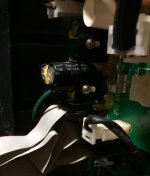Hi! I've got my pair of Opals in 2012. And there was considerable broadband hum from the start. I even exchanged my first pair to another by warranty. But new pair was with same hum. Anyway they sound great! And my room was very noisy back then. So I decided to keep them.
I've just moved to my new studio which is really very quiet (no single fan and good soundproofing). And the hum becomes a problem.
I have some experience with repair of synthesizers and other electronics. So I believe I could fix it with some basic information. Is grounding of in-out of NE5532 unused channel the cause of this hum? Or may be other things to look at as well?
Thanks for any info!
I've just moved to my new studio which is really very quiet (no single fan and good soundproofing). And the hum becomes a problem.
I have some experience with repair of synthesizers and other electronics. So I believe I could fix it with some basic information. Is grounding of in-out of NE5532 unused channel the cause of this hum? Or may be other things to look at as well?
Thanks for any info!
Thanks for fast answers!
There is same amount of hum with or without input plugged in. For now I have to use unbalanced input sadly (my main audio interface also needs some servicing).
There is same amount of hum with or without input plugged in. For now I have to use unbalanced input sadly (my main audio interface also needs some servicing).
Hi, I found this thread looking for help/information for my Opals.. I own them as second user since about 8 years and recently one of the speakers started to make a sine sweep after switching it off. It's like when turning it off after a delay of around 5 seconds the sweep starts from low frequency to high frequency decreasing in volume over around 4-5 seconds. The same speaker also doesn't do the speaker membrane "plop"anymore when turning it on. Other than that it works fine but I am worried using it since this could potentially lead to a bigger problem? Do you have any hints what might be the problem / fault? I feel confident opening it up and doing some generic work like swapping some capacitors etc, but I might not have the required skills / tools to recalibrate them if that would be required. Nevertheless, I'd appreciate some help, if somebody knows what this behaviour might hint to and I really hope that I can fix them since I really don't wanna thing about replacing them.. Cheers!
Electrolytic decoupling capacitors drying out perhaps? Its worth checking the power supply rail voltages anyway, so long as you can do it safely.
Hi! While I have nothing to say about sweep (my Opals turn off with bump). Do you have hum on your Opals? I am asking because mine do have from the first day. And I am finally trying to fix it. If you open up your Opals, could you please take a photo of power supply board? I would like to compare it with mine: how grounding is realized on a unit with no hum. Thanks!Cheers!
There are quite a few current and former Opal owners on the https://www.maverick-hifi.com/ forum, I suggest asking there. I checked these speakers out about a year or so ago, back then spares where still being sold by some guy, I can’t remember the URL.
I won't have time before Christmas, but I'll take some fotos when I open them up. I don't have a hum on mine, just the normal "noise floor" when they are idle.. they are working all fine, only that sweep on one of them is worrying me, gonna check the supply voltages as suggested and if I am lucky maybe a cap already screams at me to replace it 🙂Hi! While I have nothing to say about sweep (my Opals turn off with bump). Do you have hum on your Opals? I am asking because mine do have from the first day. And I am finally trying to fix it. If you open up your Opals, could you please take a photo of power supply board? I would like to compare it with mine: how grounding is realized on a unit with no hum. Thanks!
Some opal documentation: https://www.jkwynn.co.uk/Opals/Opal_Thumbs.html
I've just isolated my hum problem. It were pots on the front panel. I cleaned them well with contact cleaner and now hum is almost gone. There is still little noise but that is already acceptable.
Hello everyone.
I also have Event Opal monitors. I bought them used in February of this year. The seller said that they were stored as a reserve and were not used for a long time. The monitors sounded great and clear. When turned off, both produced a sweep frequency from low to high and movement of the woofer. But I thought it was normal, since the same thing was observed on old Tannoys and JBL.
In October, the woofer of one of the monitors began to rustle and crackle, like a vinyl record. This effect is observed even without connecting the XLR. It just makes a crackling sound on its own.
Inside the monitor, I found four swollen electrolytic capacitors on the main and power boards. (They are 35V 4700uF and 50V 4700uF). Replacing them did not solve the crackling problem. Moreover, the working monitor also had swollen capacitors (measured 1800-2200 μF instead of the nominal 4700 μF). In the photos, the capacitors have already been replaced and filled with silicone shrink-resistant compound.
But after replacing the capacitors, the sweep tone disappeared when turning off.
When installing the contour board from the working monitor, there is no crackling. I think the problem is in the contour board. Somewhere in the low-frequency correction circuit.
The Opal production dates on the outside (stickers on the upper holder) are 08/2012 and 05/2013. The working monitor has two additional resistors near TL072, on top of the daughter boards. (The daughter boards are installed on the main one). The faulty one does not have this.
The supply voltage was stable 240 volts. The monitors did not overheat, they were used quietly, in the bedroom. I've only encountered bad electrolytic capacitors in rental, overheated, or very old equipment before, so I don't understand why this happened to a factory branded unit that's only ten years old.
I also have Event Opal monitors. I bought them used in February of this year. The seller said that they were stored as a reserve and were not used for a long time. The monitors sounded great and clear. When turned off, both produced a sweep frequency from low to high and movement of the woofer. But I thought it was normal, since the same thing was observed on old Tannoys and JBL.
In October, the woofer of one of the monitors began to rustle and crackle, like a vinyl record. This effect is observed even without connecting the XLR. It just makes a crackling sound on its own.
Inside the monitor, I found four swollen electrolytic capacitors on the main and power boards. (They are 35V 4700uF and 50V 4700uF). Replacing them did not solve the crackling problem. Moreover, the working monitor also had swollen capacitors (measured 1800-2200 μF instead of the nominal 4700 μF). In the photos, the capacitors have already been replaced and filled with silicone shrink-resistant compound.
But after replacing the capacitors, the sweep tone disappeared when turning off.
When installing the contour board from the working monitor, there is no crackling. I think the problem is in the contour board. Somewhere in the low-frequency correction circuit.
The Opal production dates on the outside (stickers on the upper holder) are 08/2012 and 05/2013. The working monitor has two additional resistors near TL072, on top of the daughter boards. (The daughter boards are installed on the main one). The faulty one does not have this.
The supply voltage was stable 240 volts. The monitors did not overheat, they were used quietly, in the bedroom. I've only encountered bad electrolytic capacitors in rental, overheated, or very old equipment before, so I don't understand why this happened to a factory branded unit that's only ten years old.
Attachments
-
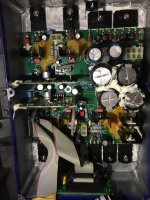 EvOp_AMP_MBoard_ok.jpg274.2 KB · Views: 61
EvOp_AMP_MBoard_ok.jpg274.2 KB · Views: 61 -
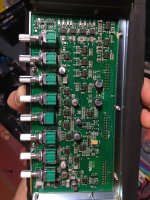 EvOp_ContourBoard_All.jpg314.7 KB · Views: 63
EvOp_ContourBoard_All.jpg314.7 KB · Views: 63 -
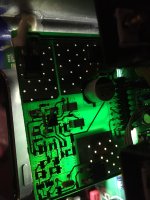 EvOp_DBoard_Rev10_Mod_T.jpg205.6 KB · Views: 58
EvOp_DBoard_Rev10_Mod_T.jpg205.6 KB · Views: 58 -
 EvOp_DBoards_Rev10_Mod.jpg227.2 KB · Views: 50
EvOp_DBoards_Rev10_Mod.jpg227.2 KB · Views: 50 -
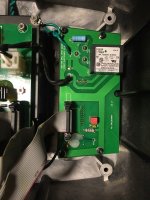 EvOp_InBoard.jpg251.7 KB · Views: 61
EvOp_InBoard.jpg251.7 KB · Views: 61 -
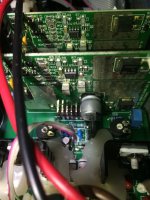 EvOp_DBoards_Rev10_Std.jpg238.6 KB · Views: 63
EvOp_DBoards_Rev10_Std.jpg238.6 KB · Views: 63 -
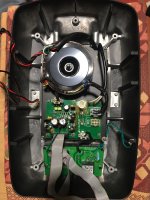 EvOp_Inside_01_WPBoard.jpg276.8 KB · Views: 56
EvOp_Inside_01_WPBoard.jpg276.8 KB · Views: 56 -
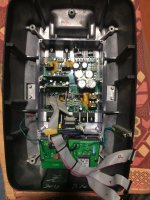 EvOp_Inside_02_OK.jpg271.3 KB · Views: 64
EvOp_Inside_02_OK.jpg271.3 KB · Views: 64 -
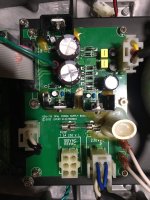 EvOp_PSBoard.jpg247.1 KB · Views: 65
EvOp_PSBoard.jpg247.1 KB · Views: 65
thank you very much, this sounds pretty much exactly how one of my speakers behaves apart from the crackling noise, but now that you mention it, I might actually have had this too already, and thought it might have been a bad connection in the studio setup. At least I haven't heard any crackle for a couple of months now.. The crackling problem could be related to the connectors or bad/dusty potentiometers on the contour board maybe? I'll put my Opals on hold for now until I find time to open them up, but I guess I'll find some bad caps inside too (also gonna check the for now flawless speaker..)..Hello everyone.
I also have Event Opal monitors. I bought them used in February of this year. The seller said that they were stored as a reserve and were not used for a long time. The monitors sounded great and clear. When turned off, both produced a sweep frequency from low to high and movement of the woofer. But I thought it was normal, since the same thing was observed on old Tannoys and JBL.
In October, the woofer of one of the monitors began to rustle and crackle, like a vinyl record. This effect is observed even without connecting the XLR. It just makes a crackling sound on its own.
Inside the monitor, I found four swollen electrolytic capacitors on the main and power boards. (They are 35V 4700uF and 50V 4700uF). Replacing them did not solve the crackling problem. Moreover, the working monitor also had swollen capacitors (measured 1800-2200 μF instead of the nominal 4700 μF). In the photos, the capacitors have already been replaced and filled with silicone shrink-resistant compound.
But after replacing the capacitors, the sweep tone disappeared when turning off.
When installing the contour board from the working monitor, there is no crackling. I think the problem is in the contour board. Somewhere in the low-frequency correction circuit.
The Opal production dates on the outside (stickers on the upper holder) are 08/2012 and 05/2013. The working monitor has two additional resistors near TL072, on top of the daughter boards. (The daughter boards are installed on the main one). The faulty one does not have this.
The supply voltage was stable 240 volts. The monitors did not overheat, they were used quietly, in the bedroom. I've only encountered bad electrolytic capacitors in rental, overheated, or very old equipment before, so I don't understand why this happened to a factory branded unit that's only ten years old.
rosarauschen,
Yes, they have a problem with the quality of the potentiometers. After some time, their contact group oxidizes and rustling and crackling appears when changing their position. Sometimes, the rustling may remain after rotation, but disappears if you lightly tap on the regulator. I also had a situation when the switch suddenly began to rustle on its own, but stopped after tapping and moving it. But in such a situation, the crackling was from both the woofer and the tweeter. And now the vinyl crackling only comes from the woofer. I think that it appears after the room equalizer section. Because in the shelf section, there is already separate processing of the low-frequency and high-frequency components. But in any case, I will clean and lubricate the potentiometers.- Home
- Amplifiers
- Solid State
- Event Opal Amps Puzzle
 👏
👏